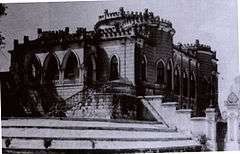Asman Garh Palace
| Asman Garh Palace | |
|---|---|
 | |
| General information | |
| Type | Royal Palace |
| Architectural style | Gothic |
| Location | Hyderabad, Telangana, India |
| Completed | 1885 |
Asman Garh Palace is a palace located in Hyderabad, Telangana, India. The name meaning, Asman for Sky, and Garh for home, since the palace was located so high on a hillock. The palace hosted a museum displaying archaeological relics. The palace presently is converted into a school (St Joseph's Public School, Asman Garh Palace branch)Located near the T.V. Tower at Malakpet, the Asmangarh Palace was constructed in 1885 by the Paigah Noble Sir Asman Jah. The Asmangarh Palace is located on a hillock with a commanding view of the surrounding forest, which served as a hunting preserve for the Nizam and his courtiers.
History
The Asmangarh Palace is located on a hillock with a commanding view of the surrounding forest, which served as a hunting preserve for the Nizam and his courtiers. The Nizam was so fascinated by this miniature castle that he became a regular visitor. Sir Asman Jah eventually gifted it to the Nizam. It was designed personally and built by the erstwhile Prime Minister of Hyderabad state Sir Asman Jah in 1885 on a hillock for leisure. He belonged to the Paigah family. He fulfilled his dream of building a home close to the sky. His real name was Mohammed Mazharuddin Khan, he was the grandson of the second Nizam, Sikander Jah Unused for quite sometime, the palace was leased to the Birlas who located their Archaeological Museum in it. After more than four decades, the Birla Museum moved out and the building is now occupied by St. Joseph's Public School. The school's principal is Mrs. Sundari and is leased for a long time. http://sjpsmalakpet.com/content/images/AGP02.jpg
Design
Its based on Gothic architecture and is in the shape of a European medieval castle. The granite turrets and arched windows of Asman Garh palace stand out.
A granite structure in Gothic style, the compact building is too small to technically qualify as a palace, let alone the European castle which no doubt inspired its construction. Its claim as a palace is however justified by its architectural style and lofty location on a high plinth. The entrance is approached by a pair of simple symmetrical staircases which lead up to a verandah with painted arches springing from slender Corinthian columns. The painted arch is repeated in the window openings. The multi-level terraced roof is topped with castellated battlements, which form the parapet and arethe most noticeable of its architectural elements. When the Nizam Mir Osman Ali Khan inherited the palace he added a unique arched gateway in the shape of the Royal Dastar (turban-like headgear, part of Hyderabad court dress and a symbol of State).